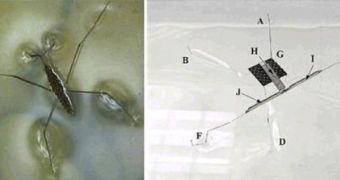Robots can do many things, these days, they can vacuum clean a room in minutes, they can sniff out and defuse bombs, some of them can walk like humans and even run and climb hills and mountains. Roboticists are pushing the limit of robot abilities to reach what only sci-fi authors have imagined.
But all these abilities pale in comparison to what a new robot can do: it can walk on water. Literally! As far as we know, only one animal in the world can do that, the water stride and another one can do it for a limited time, basilisk lizard.
Oh, yeah, there was a man who could easily do it, but we can't ask him anymore, and some people doubt it really happened: Jesus. The big breakthrough consists in the fact that this is the first manmade device that can mimic something that nature, as always, invented since the time of the dinosaurs.
The robot may not be a giant, weighing in at a mere 1 gram, but it can walk on the surface of the water, as long as it doesn't exceed 4 millimeters in depth. You can really tell that the water strider insect was the source of inspiration, since the robot's design is very similar to that of the tiny critter, only it's 10 times larger than its biological cousin.
STRIDE, as it was called by Yun Seong Song, a PhD student in mechanical engineering and Metin Sitti, assistant professor in mechanical engineering, both from Carnegie Mellon University, who built it, uses only surface tension forming at the boundary between air and water to prevent it from sinking.
It can move around at a speed of 3 cm/s - the real water strider can run at 1.5 m/s - can turn, rotate and even move backwards. It has sculling legs in a T shape to create horizontal and vertical motion which produces the same sculling motion used by the insect. Three piezoelectric actuators are attached to the 5 centimeters-long hydrophobic wire legs coated with Teflon and an amplifier is used to increase the motion.
Its makers hope that it would soon be improved to be able to move in deeper water and that its current payload of 9.3 grams will increase in future prototypes.

 14 DAY TRIAL //
14 DAY TRIAL //